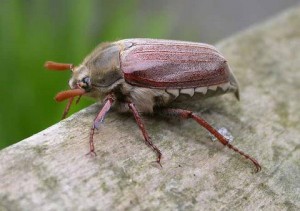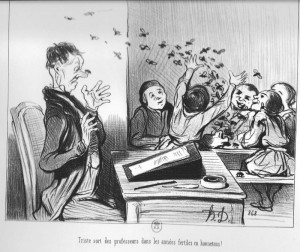 If you read yesterday’s posting, you might have wondered about what a “cockchafer” might be, a human enough reaction, and might also have been too embarrassed to ask. That’s OK, as it has nothing to do with what you might have thought it could mean. Hanneton or cockchafers are simply large, brown beetle that emerge from the ground every three years by the millions to generate more big brown beetles that will emerge from the ground three years later, somewhat like the more familiar 17-year-cicada cycle. Or I should say that cockchafer beetles used to emerge from the ground every three years, and have now basically been wiped out by pesticides. But while they were in their glory, every three years, they provided school children in Belgium with a few memorable days.
If you read yesterday’s posting, you might have wondered about what a “cockchafer” might be, a human enough reaction, and might also have been too embarrassed to ask. That’s OK, as it has nothing to do with what you might have thought it could mean. Hanneton or cockchafers are simply large, brown beetle that emerge from the ground every three years by the millions to generate more big brown beetles that will emerge from the ground three years later, somewhat like the more familiar 17-year-cicada cycle. Or I should say that cockchafer beetles used to emerge from the ground every three years, and have now basically been wiped out by pesticides. But while they were in their glory, every three years, they provided school children in Belgium with a few memorable days.
There were so many of these beetles, millions and millions of them, that farmers gathered them by the shovelful, threw them into bags, and then threw the bags into fires. However, not all cockchafers died that way. Some of them found their way to boys in the city. Often they were sold to those boys by the more resourceful farmers, grateful for a bit of extra income. In any case, during this breeding period, hannetons were very much wanted by school boys, who after they had bought them from said farmers or stores that stocked them, placed dozens of them in shoebox-sized cartons, lined the cartons with lilac leaves because that was what they were supposed to eat (and this always happened in May, when lilacs were in bloom), and brought them to school, ostensibly for purpose of comparison. Inevitably, during one of the classes, some boy would sneak a peek at the contents of his box, the lid would slip, and lo!, the classroom air was full of big, brown beetles buzzing around the room in full and dizzying flight. Naturally, we all wanted to be helpful in recapturing the flying beetles, and before you knew it, the class was in full disarray, with boys all over the place chasing flying beetles around the room, and the teacher at his desk having a fit. It was wonderful, a highlight of my elementary school education!
One of the things I find interesting about all this is how traditional it all was. It must have gone on for hundreds of years. There is a collection of cartoons and lithographs in a French magazine (Le Charivari) by Honore Daumier, published in the Mid-Nineteenth Century dealing with the “wars” between teachers and their students. One of these lithographs deals exactly with the incident described above. The caption, by the way, reads “The sad fate of teachers during the fertile years of hannetons.” The beetles’ “sad fate,” was that civilization, in the form of pesticides, has practically wiped them out, and ended this kind of fun for children, and possibly even for their wise teachers, not to mention what it has done to the environment.

Dare we refer to this as the Holocaust of the Cockshafers?
We could, but we shouldn’t. It would probably be in bad taste.
PP